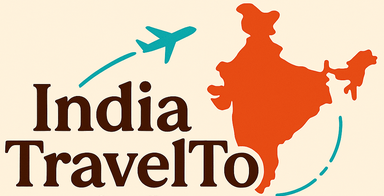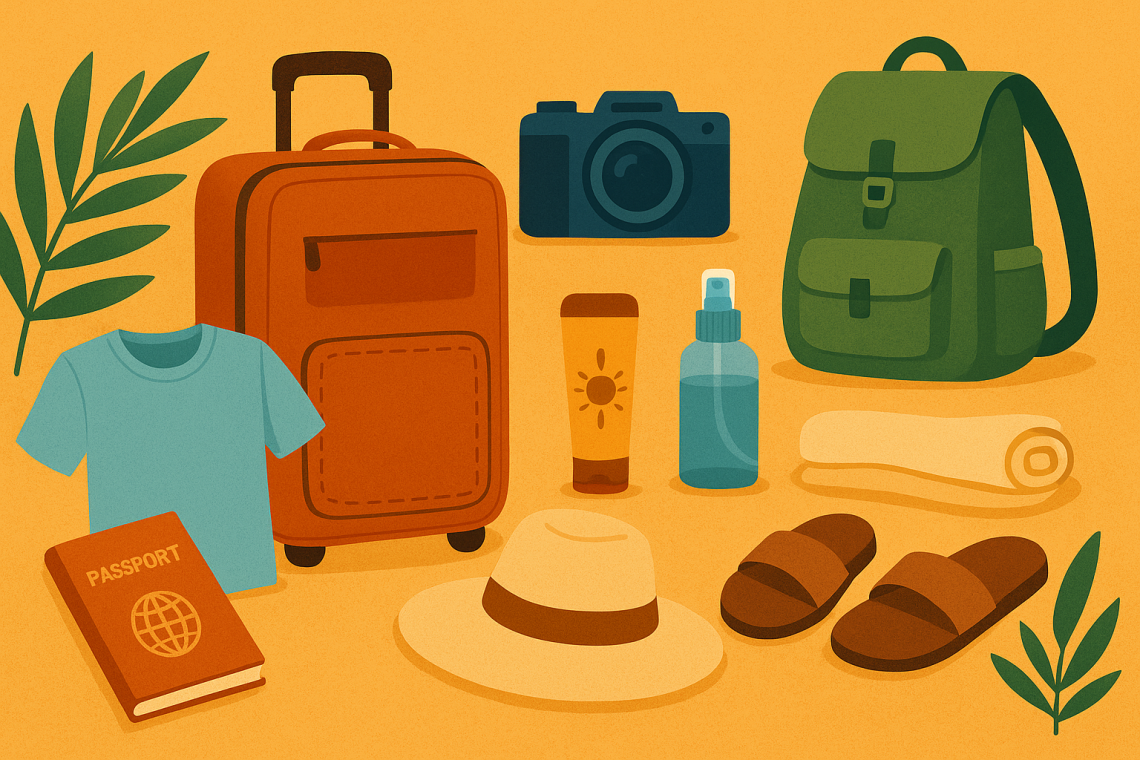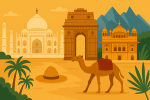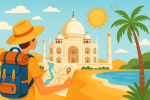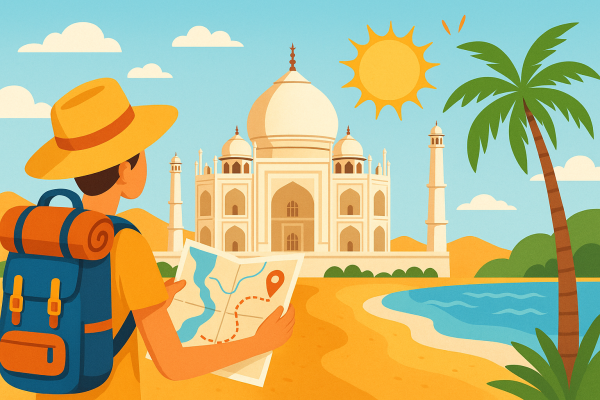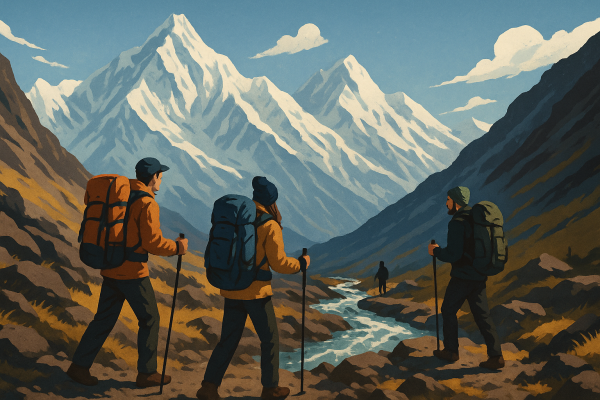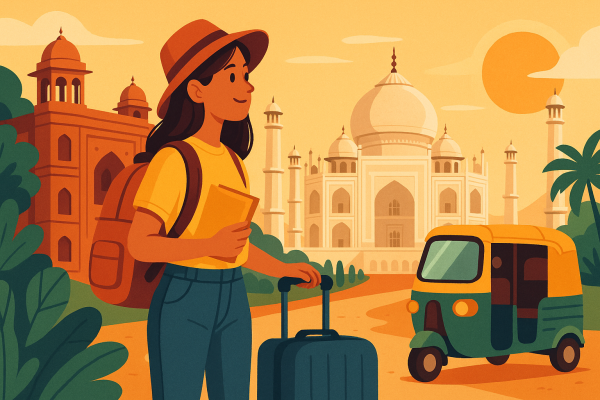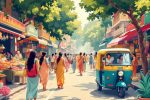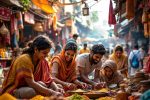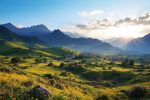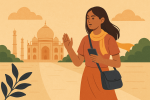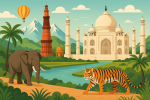What to Pack for a Trip to India: Travel Essentials
Dreaming of India’s vibrant culture and stunning landscapes? This guide ensures a smooth and unforgettable trip! Learn about essential visa and passport requirements, recommended vaccinations, and crucial packing tips. Discover how to dress respectfully for temple visits, stay safe with mosquito repellent, and navigate India’s diverse terrain with the right footwear. Prepare for your incredible Indian adventure now – read on to start planning!
Important information
- Passport and Visa: Your passport must be valid for at least six months after your arrival date. Most nationalities need a visa; consider the e-Tourist Visa, which you can obtain online.
- Health Preparations: Consult your doctor about recommended vaccinations like Hepatitis A and Typhoid. Pack a first-aid kit with essentials like bandages, antiseptic wipes, pain relievers, and mosquito repellent with DEET.
- Clothing: Pack light, breathable clothing like cotton and linen. Dress modestly when visiting religious sites. Comfortable walking shoes are important, and sandals are useful for casual outings and temples.
- Essential Items: Carry a filtered water bottle to stay hydrated. Bring cash for local markets and credit cards for larger establishments. A day bag is handy for carrying essentials.
- Electronics: Remember a universal travel adapter and a portable power bank. If you’re bringing a camera, pack extra batteries and memory cards.
Entry Requirements for Traveling to India
Planning a trip to India? Here’s what you need to know:
Passport Validity: ensure your passport is valid for at least six months beyond your intended arrival date.
Visa Requirements: most nationalities require a visa. Many can obtain an e-Tourist Visa online up to a month before departure.
Travel Insurance: while not mandatory, travel insurance is strongly recommended.
Passport Validity
For your trip to India, your passport must be valid for at least six months beyond your arrival date.
Visa Requirements
Planning a trip to India? Most travelers need a visa. The e-Tourist Visa is a convenient option. Apply online up to a month before your departure. Visa regulations vary by nationality, so confirm the specific requirements for your country before you go.
Importance of Travel Insurance
Travel insurance is essential for protecting yourself from unforeseen expenses, such as medical emergencies abroad or trip cancellations. It also provides coverage for lost baggage, offering peace of mind and a smoother travel experience. Because policies vary, selecting one that meets your specific needs is crucial. Consider these factors when choosing travel insurance:
- Coverage details: understand what is covered and what is not, including medical expenses, trip interruptions, lost baggage, and other potential issues.
- Policy limits: check the maximum coverage amounts for each category to ensure they are sufficient for your needs.
- Deductibles and premiums: compare the deductibles you’ll have to pay and the premiums charged by different insurers.
- Exclusions and limitations: be aware of any specific exclusions or limitations, such as pre-existing conditions or adventure activities.
- 24/7 assistance services: confirm the availability of 24/7 assistance services, including medical and travel support.
Health Precautions and Medicines
Planning a trip to India? Ensure you’re protected with necessary vaccinations. Consider vaccinations for Hepatitis A and B, Typhoid, and MMR (measles, mumps, and rubella). Keep your routine immunizations up-to-date. A well-stocked first-aid kit is essential for your trip. Pack antiseptic wipes, bandages, pain relievers, anti-diarrheal medication, and motion sickness tablets. Don’t forget insect repellent containing DEET for protection against mosquitoes and other biting insects. For personalized health recommendations based on your itinerary and specific needs, consult your doctor or a travel health specialist.
Recommended Vaccines
For safe travels, we recommend vaccinations against hepatitis A and typhoid to protect you from food- and waterborne illnesses. We also recommend getting vaccinated against yellow fever if your itinerary includes jungle areas. Consult your doctor for personalized advice and necessary precautions based on your health status and travel plans.
Essential Medicines and First-Aid Kit
A well-stocked first-aid kit is essential for handling minor injuries like cuts and scrapes. Beyond the basics, consider these additions: hydrocortisone cream, antifungal and antibacterial ointments, antiseptic wound cleanser, aloe vera gel for burns, and insect bite relief. Bandaging supplies are also key. Include various bandages, moleskin for blister prevention, elastic wraps for support, and gloves to maintain hygiene. A thermometer helps monitor fevers, while scissors, cotton swabs, and tweezers address various needs. Eye drops can soothe irritation, and oral rehydration salts combat dehydration. Don’t forget personal prescription medications and over-the-counter remedies like pain relievers and anti-diarrheal medication. Electrolyte packets are excellent for replenishing lost fluids and electrolytes.
Essential additions
- Hydrocortisone cream.
- Antifungal and antibacterial ointments.
- Antiseptic wound cleanser.
- Aloe vera gel for burns.
- Insect bite relief.
Bandaging supplies
- Various bandages.
- Moleskin for blister prevention.
- Elastic wraps for support.
- Gloves to maintain hygiene.
A thermometer helps monitor fevers, while scissors, cotton swabs, and tweezers address various needs. Eye drops can soothe irritation, and oral rehydration salts combat dehydration. Remember any personal prescription medications and over-the-counter remedies like pain relievers and anti-diarrheal medication. Electrolyte packets are excellent for replenishing lost fluids and electrolytes.
Mosquito and Insect Protection
When packing for your trip, don’t forget mosquito repellent containing DEET or picaridin. These ingredients provide robust protection against mosquito-borne diseases like malaria, dengue fever, and chikungunya. Furthermore, the repellent is also effective against other bothersome insects.
Clothing and Wearables for India
Clothing
Given India’s warm climate, choose lightweight and breathable fabrics like cotton and linen for optimal comfort. Loose-fitting styles are ideal, promoting air circulation. Long sleeves and pants offer sun protection without sacrificing comfort.
Temple Attire
When visiting temples, dress modestly out of respect for local customs. Women can choose long skirts, loose tunics, or traditional garments such as kurtas. Men should wear long pants and shirts with sleeves. A scarf or shawl can be useful for women to cover their heads or shoulders.
Footwear
Comfortable footwear is crucial for navigating India’s diverse terrain. Pack sturdy walking shoes suitable for long distances and varied surfaces. Sneakers are great for city exploration. Sandals or flip-flops are convenient for casual outings and temple visits, where shoes are often removed.
Lightweight and Breathable Fabrics
India’s warm climate makes lightweight, breathable fabrics ideal for comfortable travel, such as cotton and linen. Loose, long sleeves offer excellent sun protection. A light scarf provides warmth when needed and can also cover your shoulders at religious sites.
Modest Dress Code for Temple Visits
When visiting temples, choose loose, comfortable clothing. Ideal options include long skirts or pants, and a shawl or cover-up is a respectful addition in line with local customs. Lightweight linen pants and shirts are perfect for staying cool while maintaining modesty, as are flowy skirts and dresses. Scarves offer incredible versatility, serving as a cover-up in temples and providing protection during dust storms.
Footwear for Comfort and Safety
When packing for your trip to India, prioritize comfortable and durable sneakers. You’ll need supportive footwear for the diverse terrains, from dusty roads to the uneven surfaces of historical sites.
Everyday Travel Essentials
Pack strategically for a smooth trip. A filtered water bottle ensures safe hydration. Carry cash for local markets and smaller vendors, while credit cards are convenient for larger purchases. A day bag is ideal for daily excursions, holding essentials like toiletries. Pack these toiletries: toothbrush, toothpaste, deodorant, and sunscreen. Don’t forget necessary medications and a small first-aid kit. The kit should include bandages, antiseptic wipes, and pain relievers. Finally, mosquito repellent is crucial, particularly during monsoon season.
Water Bottle with Built-in Filter
Stay hydrated safely anywhere with a filtering water bottle. Refill it from virtually any source, and the built-in filter purifies the water for you. This eco-friendly choice reduces plastic waste, a particularly important benefit in areas where finding clean drinking water can be a challenge.
Cash, Credit Cards, and Day Bag
Local markets and small shops prefer cash payments.
For daily excursions, a small backpack or day bag is essential for carrying necessities like water, sunscreen, and a camera.
Credit cards are more convenient in larger stores, restaurants, and hotels.
Toiletries and Personal Care Items
Packing your toiletries is essential for a comfortable trip. Here’s a checklist to ensure you have everything you need:
- Essentials: toothbrush, toothpaste, shampoo, conditioner, soap, and deodorant.
- Personal hygiene: Don’t forget items like feminine hygiene products.
- On-the-go freshness: Hand sanitizer and wet wipes are crucial.
- Organization: A toiletry case keeps everything tidy, especially for overnight travel.
- Hair care: Dry shampoo is convenient, especially when hot water is scarce.
- First-aid: Pack a small kit with pain relievers, antibiotic cream, and mosquito repellent.
Electronics and Accessories
Planning a trip to India? Don’t forget these essential tech gadgets:
- A universal travel adapter is crucial, as India uses plug types C, D, and M, ensuring your devices stay charged.
- A portable power bank is a must-have for keeping your electronics powered up while exploring.
- To capture India’s stunning landscapes and vibrant culture, pack a camera along with extra memory cards and batteries.
- While a tripod can be useful, remember that some monuments, like the Taj Mahal, restrict their use.
Universal Travel Adapter and Power Bank
When venturing to India, remember to pack a universal travel adapter, essential for navigating the diverse electrical outlets and keeping your devices powered up. A portable power bank is another smart choice, ensuring your electronics stay charged during your travels, especially helpful during long journeys or unexpected power outages.
Camera and Photography Equipment
To capture India’s breathtaking scenery, a camera is essential. Bring ample memory cards and your charger. A tripod can significantly enhance your photography, but be sure to check regulations beforehand, as some monuments restrict their use. Consider these essential photography tips for your trip to India:
- Camera: pack a versatile camera suitable for various shooting conditions,
- Memory Cards and Charger: ensure you have enough storage and power to capture all your memories,
- Tripod: while a tripod can enhance stability and creativity, check regulations as some locations may restrict their use.
Additional Tips for Traveling in India
Traveling light makes your journey smoother. Pack versatile, breathable clothing and dress in layers to adapt to changing weather. A small, foldable daypack is perfect for daily excursions.
Essential items for your trip:
- Filtered water bottle, to stay hydrated.
- Universal adapter, to keep your devices charged.
- Offline maps and translation apps, to simplify navigation and communication.
More essential items:
- Small first-aid kit with necessary medications and antiseptic wipes.
- Scarf, for warmth, sun protection, or modesty at religious sites.
Packing Strategy for a Comfortable Trip
Pack light for your India adventure to maximize souvenir space. Choose versatile, lightweight, quick-drying clothing. A small daypack is perfect for daily excursions. Limit your shoes to a comfortable, practical pair. Packing clothes for just a few days and doing laundry during your trip will save space and weight. Consider these packing tips for your trip to India:
- Pack versatile, lightweight clothing.
- Bring a small daypack.
- Limit shoes to one comfortable pair.
Practical Items for Daily Use
Pack these essentials for a comfortable and safe trip:
- Hygiene items: hand sanitizer, baby wipes (for freshening up before meals), toothbrush, razor, deodorant, and other toiletries.
- Heat relief: cooling towels for quick relief from high temperatures.
- Medications: daily prescriptions, pain relievers, stomach remedies (anti-nausea and anti-diarrheal medications).
- Sun and bug protection: sunscreen and mosquito repellent.
- Daily necessities: cash, credit cards, and a small backpack for purchases and short trips.
